Best Pig Breeds to Raise on Pasture
While many pig farmers keep their pigs in pens or paddocks, pigs have been raised on pasture for thousands of years. Today, pastured pork has made a comeback and is more popular than ever, with the focus for many moving toward sustainable and eco-friendly foods. If you are considering raising pigs on pasture, you will want to know which breeds perform best in this type of environment.
What are 10 of the best pig breeds that you can raise on pasture? You can raise any breed of pig on pasture, but some will be more successful in this environment than others. The 10 best pigs to raise on pasture are:
- Tamworth
- Large Black
- Berkshire
- Hereford
- Mangalitsa
- Red Wattle
- KuneKune
- Hampshire
- Duroc
- Chester White
There are certain factors that make some breeds of pig more successful on pasture than others. A successful pasture pig will excel at converting pasture and forage to growth (meat) than others. A successful pasture pig will be a voracious forager, and a good mother. If you are keeping pigs on pasture, you will also want a somewhat docile breed – herd management will require that you walk through the pasture, and you don’t want to walk through a pasture of aggressive hogs. To learn more about the pig breeds listed above, read on!
Pasture Pig #1: Tamworth
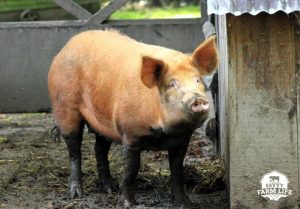
The Tamworth is at the top of this list because it has been bred for centuries to thrive on forage. This breed was developed in the densely forested regions of central England, and were bred to have long heads and especially strong snouts. These attributes, and their drive to forage, give them an advantage in the ability to provide for themselves.
Tamworth pigs are also quite athletic, having strong legs and sound feet. This gives them the ability to walk for long distances in search of food. This may not be a selling point if you have an acre of pasture to put them on, but if you have plenty of wooded acreage they will feel right at home.
Tamworth pigs have a distinct, solid red coat and are not as prone to sunburn as their lighter cousins. They mature at around 500 to 600 pounds. Tamworth sows make excellent mothers and produce large litters.
Pasture Pig #2: Large Black
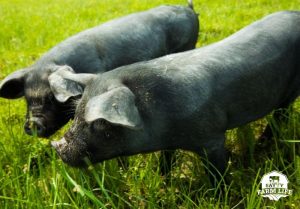
As its name implies, the Large Black pig is in fact, large and black. These pigs mature at around 600 to 800 pounds, depending on the gender, and are solid black in color. They were originally known as the “Lop Eared Black”. Large Blacks have oversized ears that flop forward onto the face – these ears are known to protect the pig’s eyes while foraging and rooting.
This breed was developed in southwestern England and was bred for its size and its impressive pasture-to-meat production. Large Blacks are still known as one of the best breeds to raise on pasture, known for their excellent foraging abilities and their feed conversion efficiency. Large Blacks are prolific breeders and sows make excellent mothers, with the ability to produce and raise large litters outdoors.
Pasture Pig #3: Berkshire

Berkshires are known for their dark, flavorful meat – sought after by many restaurants and high-end chefs. Berkshires are black pigs with white faces, legs, and tails. They have a mature weight of 500 to 600 pounds.
Berkshires are exceptional foragers, and also naturally hardy. The sows make excellent mothers, and they are able to farrow (birth) and raise vigorous piglets in the woods or pasture just as easily as in the barn.
Pasture Pig #4: Hereford
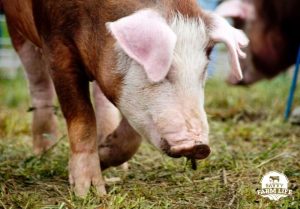
The Hereford is a relatively new breed, developed in the 1920’s in the midwestern United States. Hereford pigs have similar markings to Hereford cattle – with a red coat along its back and sides, and a white head, underside, and legs. This breed is popular in 4-H programs around the nation due to its unique appearance and docile temperament.
Herefords are large hogs and mature at 600 to 800 pounds. Like many breeds, the sows make excellent mothers and are able to produce large litters. Herefords are often raised in confinement, but do equally well on pasture. Along with its gentle disposition, Herefords are known for their adaptability and ability to thrive in almost any climate.
Pasture Pig #5: Mangalitsa
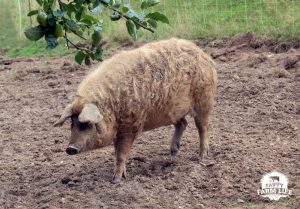
Mangalitsas stand out as the only wooly-coated pig. These pigs are distinct in their curly coats, and while they look like sheep’s wool, the hair is actually much coarser and sparser. This extra hair helps the Mangalitsa in cold climates, and they are more hardy in cool weather than many other breeds of pig. If you are looking for a more novel breed to add to your pasture, you might consider the Mangalitsa.
Mangalitsas are not known to be appropriate for large scale operations – they can take up to a year to reach a finishing weight (as opposed to the 5-6 months of some other breeds), and their litters tend to be smaller than average. However, what they lack in efficiency, they make up for in foraging abilities. Mangalitsas are excellent foragers, and thrive in heavily wooded areas. If you have a wooded lot and would like to raise a unique-looking pig, Mangalitsas may be the choice for you.
Pasture Pig #6: Red Wattle
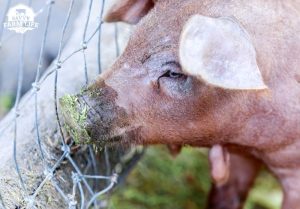
The Red Wattle is a North American breed named for its appearance – in particular, its solid red coat and small, fleshy wattles that hang from either side of its neck. These are large pigs that can mature to 800 pounds or more, though sows tend to be smaller.
Red Wattles have three characteristics that make them good pasture pigs: they are rugged and adaptable to many different climates, they are known to be excellent and effective foragers, and they produce large litters and produce a high quantity of milk for their young.
Pasture Pig #7: Kunekune
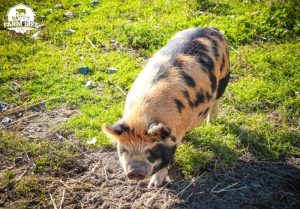
The name Kunekune translates to “fat and round” in the Maori language. Kunekunes are light colored with black spots, and relatively small – only reaching 150 – 250 pounds at maturity. This size may seem inferior, but many farmers prefer the smaller frame as they are easier to handle and manage.
Kunekunes like to graze, and are thought to be less destructive to the environment because of their upturned snouts, which makes it more difficult to root. While Kunekunes are not known for rapid growth, they are efficient at growing on pasture and forage.
Kunekunes are also known for their gentle, quiet temperaments and are a popular pig for homes with young children.
Pasture Pig #8: Hampshire
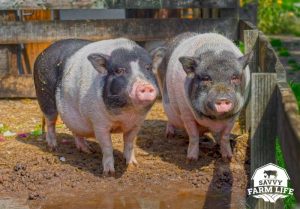
Hampshire pigs are black with white belts around the shoulder area. They reach a mature weight of 600 to 700 pounds, and were originally from northern England. When they were first imported to America, they were looked down upon because of their size large size. Hundreds of years ago, pigs were commonly butchered at 100 to 125 pounds. Their reputation was saved, however, because of their foraging abilities and general hardiness.
Hampshires are excellent foragers, making them great pasture pigs. They do particularly well in forested areas, preferring to forage in the woods over fields. They are also hardy animals, able to thrive in the outdoors in a variety of different climates.
Pasture Pig #9: Duroc
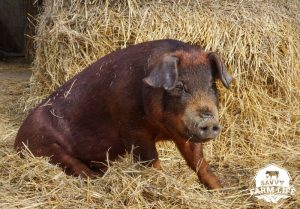
Durocs are solid red in color with floppy ears. They can reach a mature weight of 700 to 800 pounds, and are the second most popular breed of pig in the United States. Durocs are known for their large litters and ability to reach market weight at a rapid pace.
Durocs have an easy-going temperament and the sows make excellent mothers. They produce large litters and the piglets are known to be early grazers. Durocs are natural foragers, and do just as well in confinement as they do in the woods. Because of their innate foraging ability, Durocs are often used in crosses to produce larger, rapid-gaining pigs that thrive in natural environments.
Pasture Pig #10: Chester White
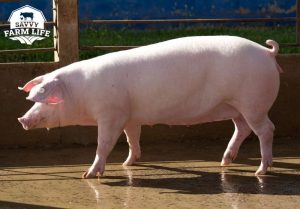
The Chester White is a medium-sized pig, maturing at around 300 to 500 pounds. As their name implies, they are usually all white in color, though will occasionally produce small spots. Chester Whites are as good at foraging as most other breeds, though they can be successfully raised in confinement as well.
Chester White are on this list for two main reasons – the sows are excellent mothers with exceptionally large litters, and pigs of this breed are known to be docile. The ability to produce large litters coupled with the fact that Chester Whites are naturally long-lived means that there is a potential to produce more piglets per sow than with other breeds. The docile temperament means that they are easier to care for and manage.
Chester Whites are also known to be relatively cold-hardy, which makes them a good option if you would like to raise pigs on pasture but experience colder Winters. One disclaimer to note – because of their light skin, Chester Whites will need access to shade during the warmer months. Light-skinned pigs are highly susceptible to sunburn where there is a lack of shade.
Which Pasture Pig Is Right For You?
There are several options when it comes to choosing the right breed of pasture pig. Don’t put too much pressure on yourself to find the perfect breed – if you start raising pigs on pasture and end up deciding the lifestyle is not for you, know that most of these breeds thrive just as well in confinement.
Want to learn more about pigs? Check out these article!
- Meat Pig Breeds: 8 Best Pig Breeds For Meat
- How Long do Pigs Live? Quick Pig Lifespan Guide
- When Can a Pig Get Pregnant? & Other Pig Pregnancy Facts
